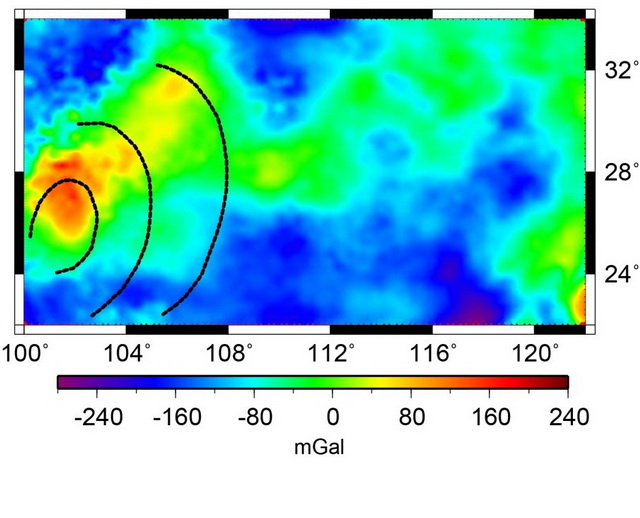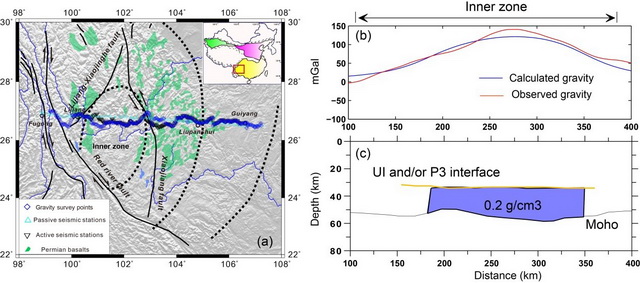In recent years, Emeishan large igneous province (ELIP) has drawn the attention of the scientific community because of its great importance in understanding the origin of intraplate igneous structures and its possible synchrony with the end-Permian mass extinctions. Many geological and geochemical studies have been conducted on the ELIP, but the deep origin is still poorly constrained. Gravity data is sensitive to the density, which provides valuable constraints on the physical state of the lithosphere that are complementary to the seismic data.
Dr. DENG Yangfan and his collaborators investigated the regional residual gravity anomaly in South China, and its relationship to the ELIP, in conjunction with deep seismic sounding profiles, deep seismic reflection surveys and a variety of broadband seismic observations performed in South China during the past few decades. The resultant residual gravity anomaly in the ELIP and surrounding region reaches a maximum value of +150 mGal and decreases gradually with distance from this inner zone. With the conjugate gradient method, a 3D density model is proposed to explain the residual gravity anomaly. The residual gravity and density model provide evidence for the formation by the upwelling of a mantle plume.
Then, in order to understand the detailed gravity response to the magmatic process in ELIP, during the months of July and August 2012, they carried out the COMGRA-ELIP experiment for gravity measurement along a west-east 800-km-long profile that crosses the inner, middle and outer zones of ELIP. Using the stripping method, they determined the residual gravity in ELIP and surrounding areas along this profile. The residual gravity reaches a maximum value in the inner zone of ELIP. Starting from the results obtained by seismology, least squares variance analysis and with the help of the trial-and-error method, they propose a strong density contrast of 0.2 g/cm3 (density of 3.14 g/cm3) for the 15- to 20-km thick igneous layer accreted at the base of the crust, as evidence of crustal underplating in ELIP related to the Permian mantle plume, to explain the present-day residual gravity anomaly.
Financially support by the National Basic Research Program of China (973 Program, grant 2011CB808904) and the National Nature Science Foundation of China (41021063), these studies are published in Lithos and Tectonophysics.
Deng, Y.*, Chen, Y., Wang, P., Essa, K.S., Xu, T., Liang, X., Badal, J., 2016. Magmatic underplating beneath the Emeishan large igneous province (South China) revealed by the COMGRA-ELIP experiment. Tectonophysics 672, 16-23.
Deng, Y.*, Zhang, Z., Mooney, W., Badal, J., Fan, W., Zhong, Q., 2014. Mantle origin of the Emeishan large igneous province (South China) from the analysis of residual gravity anomalies. Lithos 204, 4-13.

Figure 1 Stripped residual gravity anomaly in South China. The dash lines indicate the inner, middle and outer zones of ELIP (Image by DENG Yangfan)

Figure 2 (a) Comprehensive geophysical investigations in ELIP. Three instrument sets were deployed from west to east in this region: a gravity profile (blue diamonds indicate gravity survey points), a passive-source seismic array (pale blue triangles indicate passive seismic stations) and an active-source seismic array (black inverted triangles indicate active seismic stations). (b) Misfit between observed and calculated gravity. (c) 2D average density anomaly model due to crustal underplating. (Image by DENG Yangfan)
Contact:
Doctor DENG Yangfan
Guangzhou Institute of Geochemistry, Chinese Academy of Sciences
Email: yangfandeng@gig.ac.cn